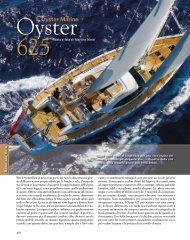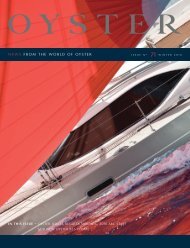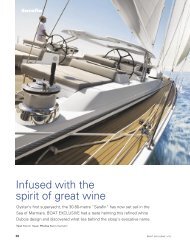You also want an ePaper? Increase the reach of your titles
YUMPU automatically turns print PDFs into web optimized ePapers that Google loves.
SAIL SETTINGBy Matthew Vincent of Dolphin SailsWelcome to Part 1 of aseries of articles designedto help you get the bestfrom your sails.Issue by issue we will begiving you some handyhints and techniques toassist you in makingyour boat sail faster,as well as extendingthe life of your sails.We will also beadvising you onthe best carefor your sails.PAY ATTENTION TOYOUR TENSIONSThe tensions applied to sails can becritical to your boat performanceand sail life. Correct tension onhalyards, genoa car position,sheets, out-hauls, battens (fullybattenedsails), leach and foot linesand backstay can make asignificant difference to both theshape of your sails and the speedof your boat through the water.In this article we will be looking atthe tensions as they apply to your headsail.Photo 1 Example of slack main halyardand very slack genoa halyardHALYARD TENSIONTo produce a shape in the sail that permits the boat to be easier to steer and also reducesexcessive heel, the halyard needs to be correctly tensioned. The correct tension positionsthe draft forward of the centre of the sail (See Diagram 1 and Photo 1 and 2)With an increase in the breeze the sail luff will appear slack. More halyard tension isrequired to maintain the draft in the correct position. A good rule of thumb is to tension thehalyard until the horizontal creases just disappear. However, It is possible to over-tensionthe halyard. If you see a hard vertical crease running up the luff of the sail, you have createdtoo much tension, and could potentially damage the sail.Note that the draft in dacron sails tends to move aft more easily than in laminate sails(which stretch less and are inherently more stable). Therefore dacron sails generally requiremore halyard adjustment than laminate sails.CAR POSITIONThe next control to look at is the headsail car position fore and aft (See Diagram 2 andPhotos 2 and 3), often referred to as the sheeting angle. Most headsails come with threevertical sets of tell-tales in the luff. To match the sail with the airflow as closely as possible,each of the tell-tales needs to stream. A good starting point is to position the car so thesheet angle aims about 40-45% up the luff, from the tack. Sail close-hauled and slowly luffthe boat. Watch how the tell-tales respond. If all tell-tales lift simultaneously then the car isSheet angle aimsat approx.40-45% up luffDIAGRAM 2 SHEETING ANGLEDIAGRAM 1 DRAFT POSITIONmaximum draft positionLuff insufficiently tensionedDraft aft of centre pointluffleachTell talesmaximum draft positionLuff correctly tensionedDraft forward of centre pointluffleach
















